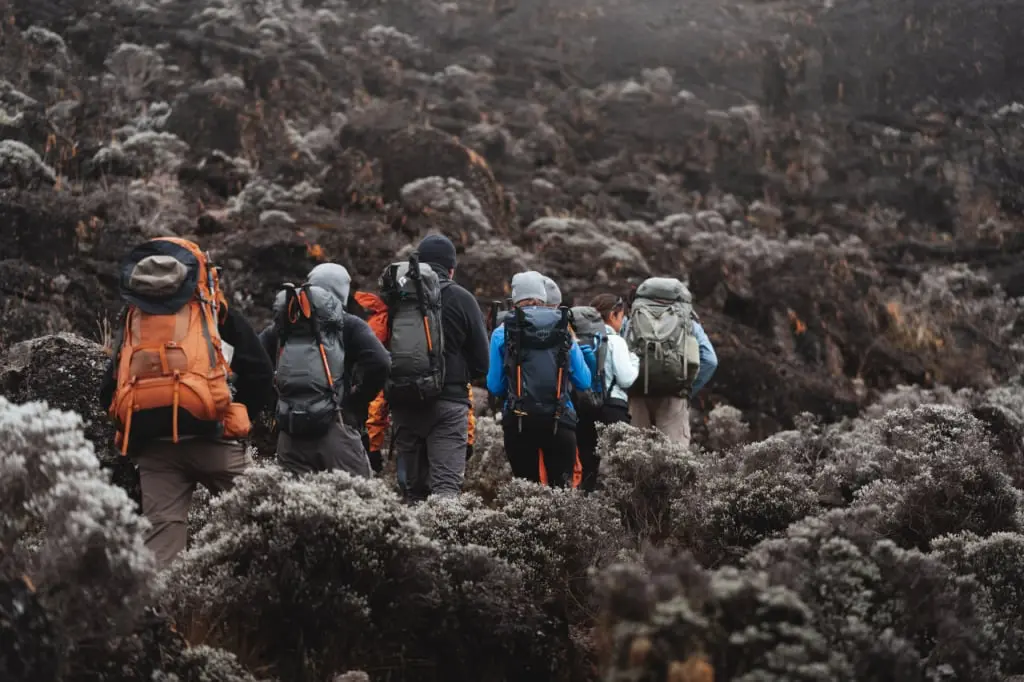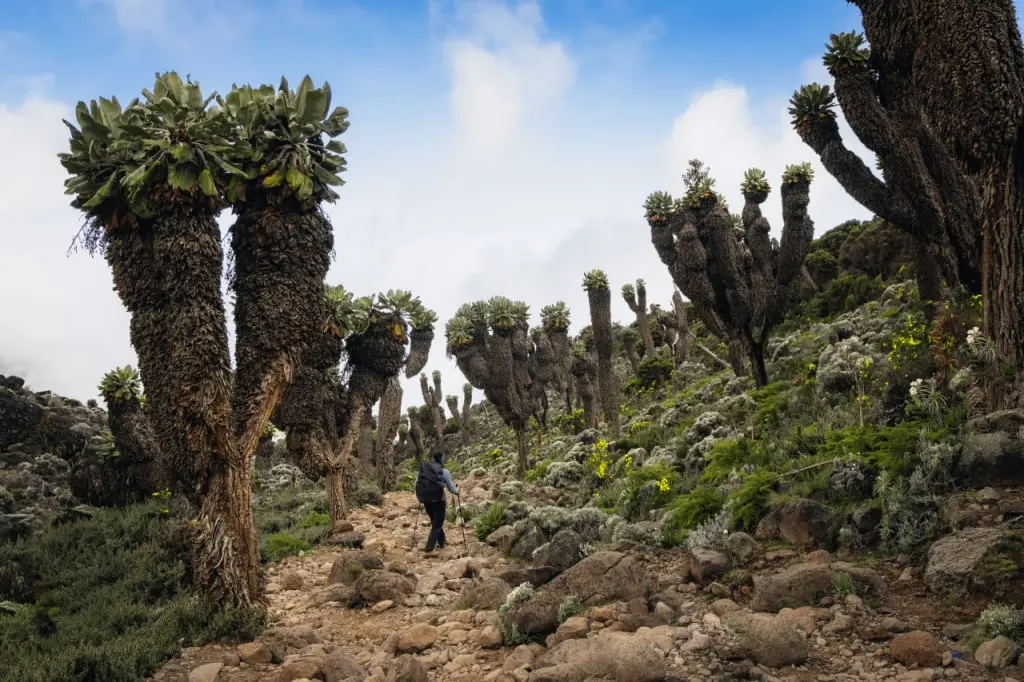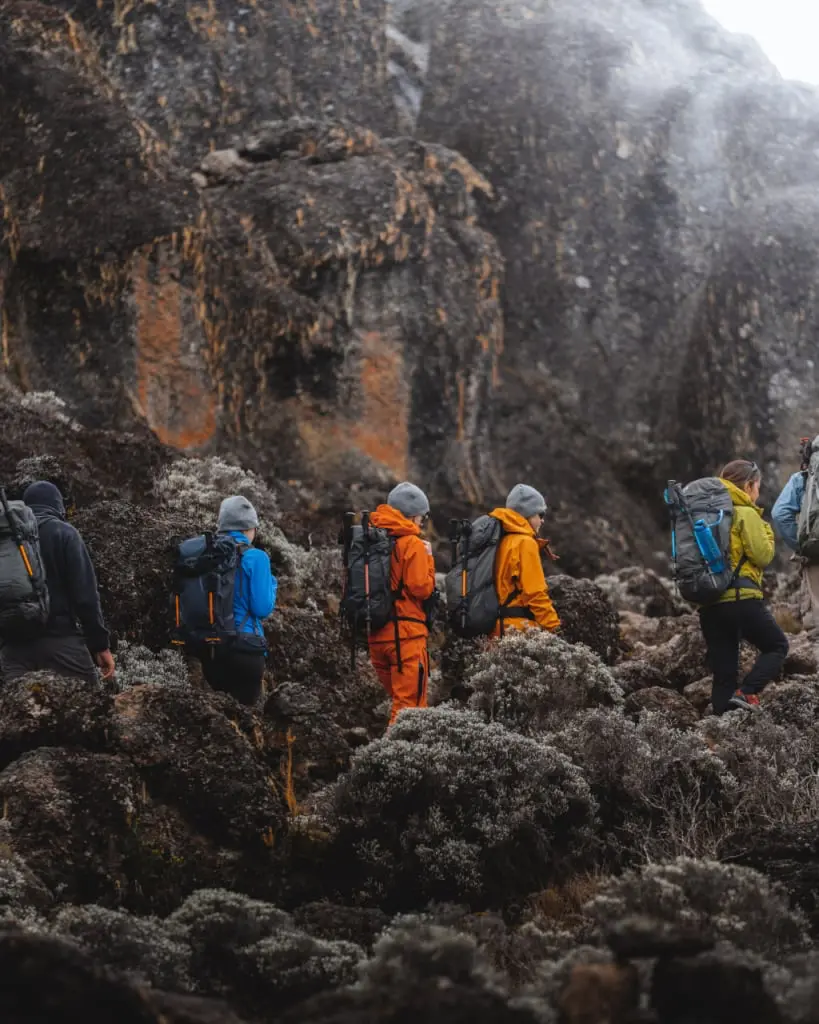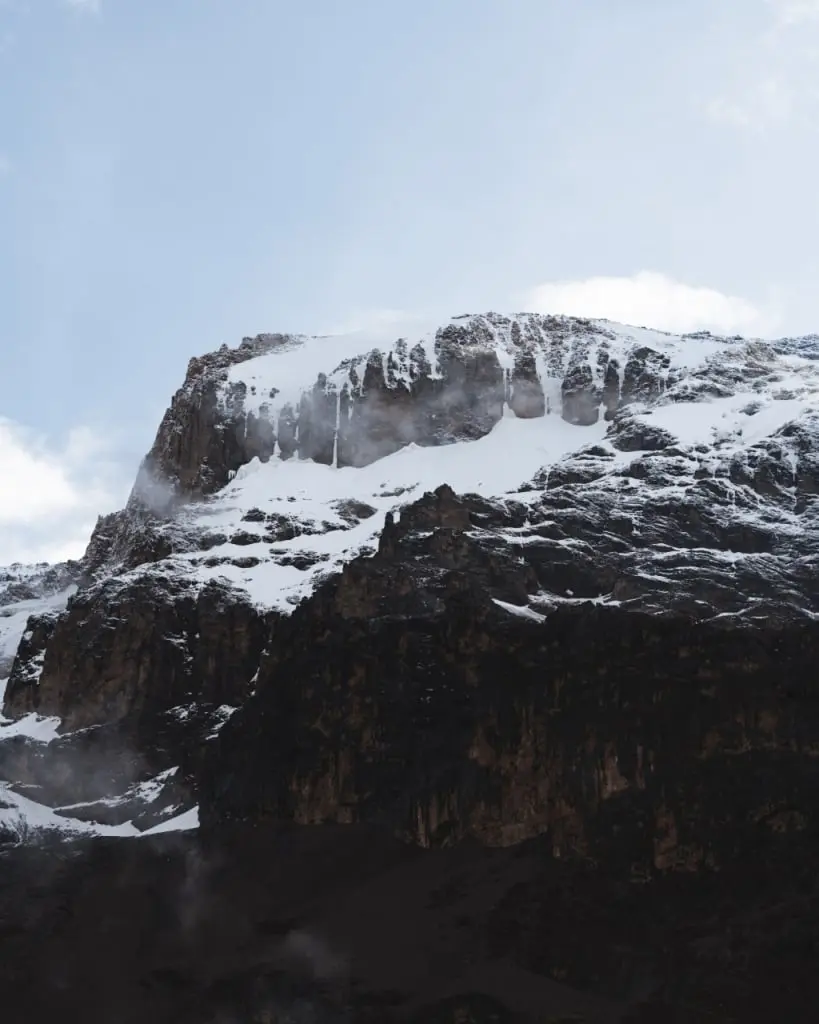Barranco Wall is a steep ridge roughly halfway up Mount Kilimanjaro. It lies at the southern base of Kilimanjaro’s main peak, Kibo. This imposing feature of the famous mountain formed long ago when Kilimanjaro was still an active volcano.
The highest mountain in Africa should offer climbers some challenges fitting for an adventurous climb. And often Barranco Wall is just that kind of moderate challenge. Our Kilimanjaro guides led thousands of clients climbing Mount Kilimanjaro to hike up the Baranco Wall. Here we will share everything you need to know about it.
From afar, Barranco Wall certainly looks like a steep mountainside climb. Some think that it needs to be scaled or climbed with special equipment or technical climbing skills. But don’t worry! As you trek closer you will see there is a stair-like path zigzagging up the steep wall.
Barranco Wall rises 257 meters (843 feet) from the Barranco Valley. Most portions of the trek are a regular trail that you can simply walk. While a few places require hikers to ‘scramble’ with the use of arms and maybe even knees. Or be a bit more careful with foot placement if the narrow path cuts between large boulders or rocks. Think of it as an early morning exercise. No trekking poles will be required.
Barranco Wall is a unique and exciting challenge. Travelers aiming to climbing Mt Kilimanjaro will face the wall on day three or four. This depends on the length of your hike along Machame, Umbwe or Lemosho Treks.
Is Barranco Wall dangerous?
For some reason, climbing the Barranco Wall has been given the reputation of being a dangerous part of Kilimanjaro trek. A quick internet search even reveals some calling it the “Terrifying Barranco Wall” or even the "Death Wall".
Such rumors and clickbait titles often scare potential climbers. So we would like to remind all adventurers looking to climb Kilimanjaro that many prefer to call Barranco “Breakfast Wall”. Now, that’s not intimidating at all, right? In fact, Barranco Wall does not require any technical climbing skills and is not nearly as dangerous as the rumor goes.
Climbing the Barranco Wall is a challenge and requires persistence and focus. But you don't need specialized gear or even to be exceptionally fit. Instead, slow and steady is the way to successfully scaling Barranco Wall.
And as with all challenges, there is a special feeling of elation and pride when climbers reach the top and are awarded with a truly magnificent view.
Death rate on Barranco Wall
There are about 5 climber deaths reported on Kilimanjaro every year (which is a lower percentage compared to most high-altitude mountains). However, no official reports of deaths were associated with the Barranco Wall.
So the definitive answer to the question "Is Barranco Wall dangerous" remains the same. It really isn't if you climb with a trustworthy Kilimanjaro operator.
Where is Barranco Wall located on Mount Kilimanjaro?
It sits on the southern slope of Mt Kilimanjaro. You will face Barranco Wall when climbing via one of the following Kilimanjaro routes: Lemosho, Machame or Umwbe. It lies on the way from Barranco Camp to Karanga Camp.
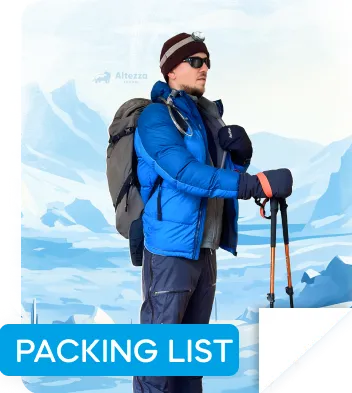
For those with a fear of heights, we recognize that climbing Barranco Wall may be an added emotional or mental challenge. And we encourage trekkers to chat with their guide if they are feeling exceptionally nervous.
This part of the trek is unique in that various climbing teams converge together and climb the steeply sloped Barranco Wall at the same time. Often, a feeling of camaraderie builds up and climbers may find complete strangers shouting encouragements. Or their team bonds in a special way as they face the rocky slopes of the Great Barranco Wall together. Sometimes, groups have a giant multi-group photo to commemorate the new friends they made while climbing Barranco Wall.
If the prospect of Barranco Wall discourages you, there are always alternatives. Just choose a different route up Kilimanjaro! No need to give up your dream of climbing Kilimanjaro over the challenge of Barranco Wall.
There are other routes to reach Kilimanjaro Summit that do not pass Barranco Wall. As it is, Barranco Wall is often considered one of the highlights of the climb by many people who climbed Kilimanjaro. Yes, right up there with reaching the summit!
In addition to that, the routes with the best acclimatization profiles - Lemosho and Machame - traverse the Wall. It is not as challenging as it might look at first sight. We unreservedly recommend everyone to visit this iconic spot on Mount Kilimanjaro!
How high is the Barranco Wall?
Barranco Wall is 257 meters or 847 feet high (from the base to the final point).
The Barranco Wall looks formidable, but, as we said above, it is totally doable. And our highly experienced guiding team is always there to ensure safety and support you in every way. We at Altezza Travel haven't had a single situation when a climber turned back because of the Wall. And most of our travelers are ordinary people with zero athletic background.
You can draw inspiration from the story of Angela Vorobeva. The brave woman climbed the Barranco Wall with Altezza at the age of 87 during her epic journey to the Roof of Africa.
What is Barranco Wall elevation?
The Barranco Wall starts at an elevation of 3977 meters and ends at 4202 meters. After that, the trail continues on much less steep ground.
Which of the seven Kilimanjaro routes go via Barranco Wall?
The routes that climb Barranco Wall on either day three or day four of the trek are the Lemosho route, Machame and the more challenging Umbwe Route.
Altezza Travel recommends the Lemosho and Machame Routes. Lemosho for a quiet, scenic hike, and Machame as the popular “Whiskey Route”.
Check out these routes in the list of our group departures.
Which routes do not climb the Barranco Wall?
If you’re interested in avoiding Barranco Wall altogether, there are other options. You can choose from the Northern Circuit, Marangu or Rongai routes that do not go via the wall.
The Marangu Route is one of the busiest routes on Kilimanjaro. So we at Altezza Travel highly recommend the Northern Circuit and Rongai routes.
Which routes descend via Barranco Wall?
No route on Kilimanjaro descends the mountain via Barranco Wall.
Almost all routes descend Kilimanjaro by a different trail than the ascent. Except the Marangu Route, which descends along the same trail. In this way, no route descends by Barranco Wall. So teams will never need to climb down the Barranco Wall - only up.
What is the Kissing Wall or Hugging Wall?
The “Kissing Wall” aka the "Hugging Wall" is a narrow portion of the trek on Barranco Wall. It requires hikers to be very close to the wall as they slowly move forward. Some call it “hugging” the wall, others jokingly call it “kissing” the wall. Because of how physically close, even intimate, climbers should be to the "kissing rock" in order to safely pass through. Hence, the name Kissing Wall has stuck. And some climbers really do kiss the wall as they go. Either in gratitude for safe passage, for luck, or just in pure fun and a great photo opportunity during the climb of Barranco Wall.
Tips for Climbing Kilimanjaro via Barranco Wall
We have prepared several tips for you to keep in mind to easily climb Barranco Wall:
- Don’t rush or try to over-exert yourself. Slow and steady is the best approach. As we say in Swahili, “pole-pole” (slowly-slowly).
- Listen to your guide. Your professional Altezza guides have climbed Barranco Wall many times. They can give advice about balance, if it’s best to put a hand on a rock, etc.
- Don’t use your trekking poles. Tie them on your pack and be free to use your hands as needed.
- “Scrambling” is the official term for using hands and even knees to climb a steep incline. There are even various grades of scrambling. But Barranco Wall is a low-grade, not requiring any special equipment or safety protocols. Some of our clients simply call it a "fun boulder scramble"
- During busy seasons the climb may feel ‘crowded’ as you wait for a team ahead to maneuver through a narrow part. Try to keep spirits up for yourself and others fellow travelers climbing Barranco Wall.
- Take time to enjoy the vistas - the views all along Barranco Wall are absolutely stunning!
- Feel proud of yourself for having successfully overcome this challenge. Take a photo of yourself or your team when you reach the top.
- Don’t feel nervous about this climb - it looks much more intimidating from afar, and many climbers report that they actually found it one of the most fun adventures of their entire Kilimanjaro climb!
What is the best time to climb the Barranco Wall?
Barranco Wall is part of the Lemosho, Machame and Umbwe routes. Usually, we recommend choosing the dry seasons (from late December to early March and early June to late September) to plan your adventure.
Consider Marangu or Rongai route if you plan to climb Kilimanjaro in April, May, October of November.
How long will it take to climb the Barranco Wall?
For most hikers climbing Barranco wall takes only one to two hours. It's still a challenge, but don't let anyone scare you by saying that Barranco Wall is a dangerous part of the Mt Kilimanjaro hike. Moreover, just 600 meters from the Barranco camp there is a helicopter evacuation point. That makes the location of Barranco Wall safer than many other remote parts of the mountain.
What else is interesting about Barranco Wall?
Magnificent dendrosenecio kilimanjari will greet you near the base of the wall. And once you reach the top of Barranco Wall, you'll be rewarded with spectacular views of the Barranco valley, Kibo volcano, and the distant Mount Meru.
All content on Altezza Travel is created with expert insights and thorough research, in line with our Editorial Policy.
Want to know more about Tanzania adventures?
Get in touch with our team! We've explored all the top destinations across Tanzania. Our Kilimanjaro-based adventure consultants are ready to share tips and help you plan your unforgettable journey.















